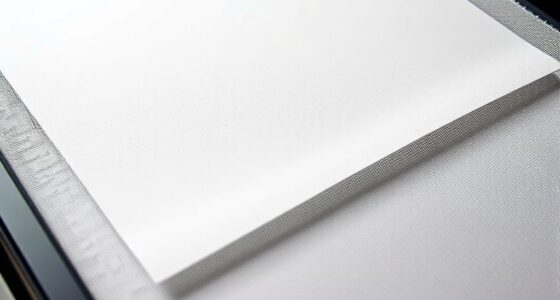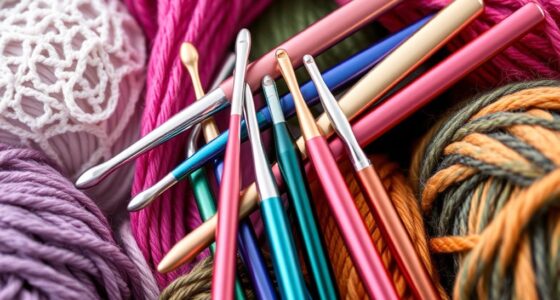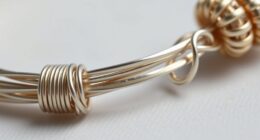To achieve durable finishes in bead stringing and crimping, focus on proper tension and secure knotting techniques to keep beads in place. Use high-quality crimp beads and sturdy crimping pliers to guarantee the ends are tightly fastened without damaging the wire. Consistent tension and neat knots prevent beads from shifting or slipping over time. If you keep practicing, you’ll discover more tips to create strong, professional-looking jewelry that lasts.
Key Takeaways
- Use high-quality crimp beads and proper crimping pliers to ensure secure, durable finishes.
- Incorporate knotting techniques to add security and prevent bead movement over time.
- Select crimp beads appropriate for wire gauge to maintain a sleek, strong hold.
- Maintain consistent tension during stringing to preserve jewelry shape and strength.
- Practice proper finishing techniques to achieve a professional, long-lasting jewelry appearance.

Bead stringing and crimping are fundamental skills for creating beautiful, professional-looking jewelry. When you’re working on a piece, the way you finish your designs can determine their durability and overall appearance. One key aspect of guaranteeing your jewelry stays intact and looks polished is mastering knotting techniques and understanding how to select the right crimp beads. These elements might seem simple, but they make a big difference in the longevity of your creations.
Knotting techniques are essential for adding security and a professional touch to your jewelry. Whether you’re making a necklace or bracelet, tying knots between beads helps prevent them from slipping or shifting over time. When you use knotting techniques like overhand knots or surgeons’ knots, you create a buffer that keeps beads in place, especially with delicate or fragile beads such as pearls or seed beads. Proper knotting also helps in hiding any excess wire or thread, resulting in a clean finish. As you practice, you’ll find that consistent tension and neat knots improve the overall look and durability of your work.
Crimp bead selection is equally important. The right crimp beads secure your wire or thread firmly, preventing your beads from unraveling or slipping off. When choosing crimp beads, consider the gauge of your wire and the type of clasp you’re attaching. Smaller, more precise crimp beads work well with fine wire, offering a sleek finish, while larger ones can accommodate thicker gauges. It’s vital to select crimp beads made from durable materials like sterling silver, crimps with a smooth surface, and those that are slightly larger than your wire’s diameter to guarantee a snug fit. Proper crimping techniques involve using high-quality crimping pliers to flatten the bead evenly, avoiding over-crimping which can damage the wire, or under-crimping that can cause slipping. Practice makes perfect here—taking your time and applying steady pressure will give you a secure, professional-looking finish.
In addition, understanding the importance of proper tension during stringing ensures that your jewelry maintains its shape and durability over time. Combining effective knotting techniques with careful crimp bead selection leads to jewelry that’s not only beautiful but also built to last. When you take the time to learn these skills, your finished pieces will stand the test of time and wear. Remember, the details matter—neat knots and well-placed crimp beads turn a simple string of beads into a polished, durable piece that reflects your craftsmanship. With patience and practice, you’ll develop an eye for what works best for each project, elevating your jewelry-making from amateur to professional level.
Frequently Asked Questions
What Types of Beads Are Best for Crimping?
You should choose beads made from sturdy materials like metal, glass, or ceramic for crimping, as they hold up well under pressure. Beads with a uniform shape, such as round or barrel-shaped, are ideal because they sit evenly, making crimping easier and more secure. Avoid beads that are delicate or irregular in shape, as they can crack or slip, compromising your jewelry’s durability.
Can I Reuse Crimp Beads for Multiple Projects?
You shouldn’t reuse crimp beads across multiple projects because they can lose their grip and compromise your jewelry’s durability. To stay organized, store your beads properly in bead storage containers, and consider recycling techniques like repurposing unused crimp beads for other craft needs. This way, you maintain quality and reduce waste, ensuring your finished pieces are secure and long-lasting. Always use new crimp beads for best results.
How Do I Choose the Right Crimping Tool Size?
To select the right crimping tool size, you need to match the tool to your crimp beads. Use the correct crimping techniques to guarantee a secure finish, and always maintain your tool by cleaning and lubricating it regularly. This prevents damage and ensures consistent results. Check the crimp bead size and select a tool specifically designed for that size for maximum durability and a professional look.
Are There Alternative Finishes to Crimping for Durability?
Sure, because who wouldn’t want a bead finish that’s as durable as crimping? You can try alternative finishes like knotting, wire wrapping, or using crimp-less clasps for non crimp solutions. These options can offer strength and a unique look, proving that durability doesn’t always require crimping. So, if you’re tired of crimping, explore these alternatives—they might just surprise you with their longevity and style.
What Safety Precautions Should I Take When Crimping?
When crimping, you should always handle sharp tools carefully to avoid cuts. Wear protective eyewear to shield your eyes from any flying debris or accidental slips. Keep your fingers clear of the crimping pliers’ jaws and work in a well-lit area. Double-check your tools are in good condition, and take your time to guarantee a secure, safe finish. These precautions help prevent injuries and ensure precision.
Conclusion
Now that you know the secrets of bead stringing and crimping, you’re ready to create jewelry that lasts like a timeless song. Think of your finished piece as a sturdy bridge, holding your creativity and effort together for years to come. With careful technique and durable finishes, your jewelry will shine brightly and withstand life’s twists and turns. So go ahead, craft with confidence—your masterpiece is just a string away from enduring beauty.








